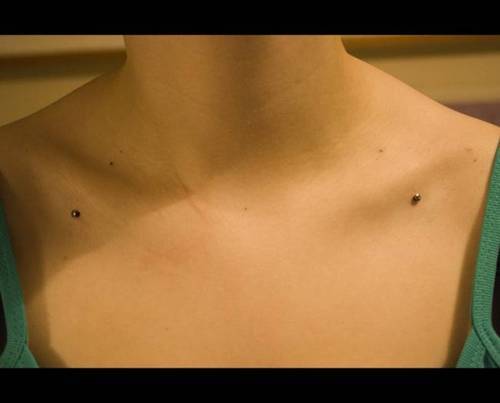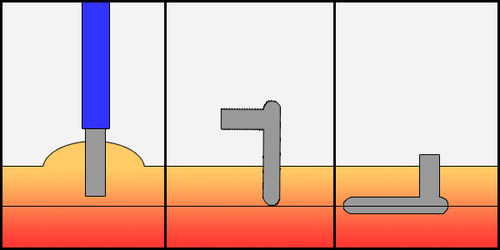 For sometime now I have had a fascination with dermal anchors, however when I bring it up to my friends and co-workers I am often met with a confused look. Even after I explain it to them they still don't really get it. So I figure it would be a good idea to do a post about it.
For sometime now I have had a fascination with dermal anchors, however when I bring it up to my friends and co-workers I am often met with a confused look. Even after I explain it to them they still don't really get it. So I figure it would be a good idea to do a post about it.A dermal implants is known by a few different names: Microdermal, surface anchor, or dermal anchor. It is simply a flat plate sitting beneath the skin with a single exit hole for a barbell post, so it looks as though the jewelery is screwed directly into the body.
There are two widely used methods (not saying there are only two ways to do it, just two very popular methods) that are done to create the anchor.
- Needle: The first method is done with a standard hollow point needle (usually a 10 gauge). It is done very similar to a standard surface piercing though it is much faster.
- The entry is marked
- The needle is then pushed through at a downward angle a few millimeters
- The long end of the anchor is then pushed into the hole
- Finally the short end is tucked in the hole as well
- Punch and Taper: The second method uses a 1.5mm dermal punch instead of a needle and is rather fast in both the piercing and healing process.
- The entry is marked
- The skin is pinched
- The dermal anchor is pressed in straight down making a hole perpendicular to the skin ending where the epidermis meets the dermis
- The anchor is then inserted down then when it reaches the end of the hole, turned inward slightly separating the epidermis and the dermis

Until next time,
Miles...

Iv been wanting one of these on my chest for a year and a half. I live in a small town in NC and its hard to find someone who can do it..correctly! You forgot to add one thing though....this procedure is permanent, unless you have it surgically removed. Especially if you had the anchor with holes on the long end, the skin bonds to it when its healing.
ReplyDeleteit is actually not permanent over time your body will push it out. and saying it has to be surgically removed sounds scary to alot of people, they can be removed at any shop that does them and for removal sometimes the area can be massaged and pinched and will loosen the skin around it enough to pop it out and if not then a needle is just inserted beside it to detach the skin from the anchor. im from a small town in NC and i have them in my chest with plans to get more. i work in a piercing shop and i am in training to be a piercer now.
ReplyDelete